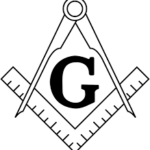
Freemason symbol
| Symbol | Freemason |
| Religion | Freemasonry |
| Origin | The precise origin of Freemasonry is subject to debate, but its roots are generally traced back to the stonemason guilds of medieval Europe. |
| Meaning | The Square and Compasses symbolize the moral and ethical framework of the organization. The square represents morality, honesty, and fair dealing, while the compasses symbolize the importance of self-restraint and discipline. |
| Appearance | The symbol typically consists of a square and a set of compasses joined together, often with the letter "G" in the center. The square is a right angle, positioned below the compasses which are set with their points towards each other. |
| Colors | The symbol is often depicted in black and white, which are considered traditional Masonic colors. However, the symbol can be found in various color schemes depending on its use and context. |
| Usage | The symbol is used by Freemasons worldwide. It appears on Masonic lodges, regalia, documents, and is used in Masonic rituals. |
| History | The symbolism of the square and compasses has evolved over centuries, incorporating elements from the stonemasons' tools of medieval Europe. It has been the official symbol of Freemasonry since at least the late 17th century. |
| Popularity | It's one of the most widely recognized symbols in the world, especially known for its associations with Freemasonry. |
| Importance | The Square and Compasses hold significant importance in Freemasonry. They are central to the teachings and rituals of the organization and symbolize the core ethical framework that guides its members. |
| Complexity | While the symbol itself is simple, its interpretation is complex and multi-layered, reflecting the rich traditions and philosophical depth of Freemasonry. |
| Emotions | The symbol often evokes a sense of mystery, tradition, and respect for the ancient wisdom and moral teachings it represents. For members of the Freemasonry, it may also evoke feelings of brotherhood, integrity, and personal growth. |
Freemason symbols are a rich and varied collection of images and emblems that are used by Freemasons to represent their values, beliefs, and teachings. These symbols, which are often drawn from architecture, geometry, and nature, have been used by Freemasons for centuries to convey complex ideas and concepts in a symbolic way.
One of the most recognizable Freemason symbols is the Square and Compasses. This symbol, which is often accompanied by the letter “G,” is a representation of the tools of the stonemason and is used to symbolize a number of things, including:
- Order and precision: The square and compasses are tools that are used to create straight lines and perfect angles, and they are thus seen as symbols of order and precision.
- Balance and harmony: The square and compasses are also used to create a circle, which is a symbol of balance and harmony.
- Wisdom and knowledge: The square and compasses are seen as tools that are used to acquire wisdom and knowledge, both of which are important to Freemasons.
Another common Freemason symbol is the All-Seeing Eye. This symbol, which is often depicted as an eye surrounded by a triangle, is a representation of God. The All-Seeing Eye is seen by Freemasons as a symbol of God’s omniscience and omnipotence.
Freemasons also use a number of other symbols, including:
- The plumb: The plumb is a symbol of verticality and uprightness. It is seen as a reminder to Freemasons to live their lives in a moral and upright way.
- The trowel: The trowel is a symbol of fraternity and cooperation. It is seen as a reminder to Freemasons to be kind and helpful to others.
- The beehive: The beehive is a symbol of industry and productivity. It is seen as a reminder to Freemasons to be productive members of society.
Freemason symbols are used in a variety of ways by Freemasons. They are often seen on Masonic buildings, in Masonic ritual, and in Masonic artwork. Freemasons believe that these symbols can help them to better understand themselves and the world around them.